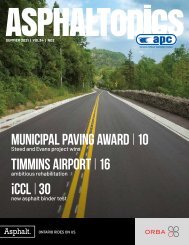ASPHALTopics | Spring 2020 | VOL 33 | NO 1
Create successful ePaper yourself
Turn your PDF publications into a flip-book with our unique Google optimized e-Paper software.
contents, the RAP asphalt binder properties. In some cases,<br />
additional aggregate tests such as polishing or mineralogical<br />
composition of the RAP aggregate may be necessary. The<br />
testing data is not only necessary for use in mix designs, but<br />
also essential for assessing uniformity of the RAP. Sampling<br />
at 1,000 tonne intervals during processing from raw RAP into<br />
a working stockpile is recommended. As with all materials,<br />
consistent RAP is important to producing consistent mixes,<br />
especially as RAP contents increase.<br />
For quality control and quality assurance purposes, it<br />
would be desirable to quantify the amount of RAP in a<br />
recycled hot mixture. If RAP is incorporated in higher<br />
amounts than approved without a proper design, it can<br />
affect the integrity of the mix and can compromise the<br />
performance and lifespan of the pavement.<br />
The National Cooperative Highway Research Program<br />
(NCHRP) Reports 452 and 752 provide a comprehensive<br />
laboratory study to answer basic questions about preparing<br />
and characterizing RAP materials for mix designs. The<br />
National Asphalt Pavement Association (NAPA) Quality<br />
Improvement Series 129 provides best practices and<br />
guidance for management of RAP (from the time of<br />
collection through processing, sampling and testing of<br />
RAP for mix design) and quality control practices during<br />
production of asphalt mixtures containing RAP. Readers<br />
interested in a concise summary about the responsible<br />
use of RAP are encouraged to consult OAPC’s (formerly<br />
OHMPA) ABCs of RAP.<br />
5. A total commitment is required from asphalt producers<br />
to ensure that maximum allowable percentages of RAP<br />
are not exceeded during production of the mix, and that<br />
the governing industry mix design guidelines are being<br />
adhered to. This is essential for developing and maintaining<br />
a relationship of trust. OAPC continues to work with all<br />
stakeholders to seek better ways of understanding asphalt<br />
materials to produce durable asphalt pavements.<br />
In summary, to use RAP responsibly, proper mix design<br />
and ethical practices should be employed. This involves: 3<br />
I. Determining the material properties of the RAP;<br />
II. Selecting an appropriate blend of RAP and virgin<br />
aggregate to meet gradation;<br />
III. Selecting the appropriate PGAC for the<br />
environment and traffic; and<br />
IV. Designing a mix to comply with the applicable<br />
contract and mix design requirements.<br />
By using RAP responsibly, the specific benefits of recycling<br />
such as reduced costs of construction, conservation of<br />
aggregate and binders, preservation of the environment and<br />
conservation of energy are achieved. All stakeholders in the<br />
road building industry MUST make an effort at this to ensure<br />
that our roadways meet their lifespan expectations.<br />
38 OAPC | ASPHALTOPICS

















